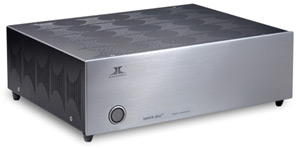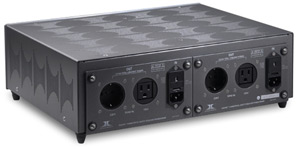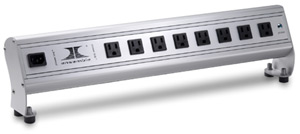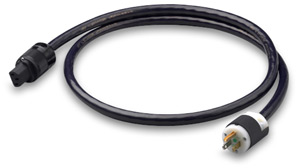![[SoundStage!]](../titles/sslogo3.gif) Home
Audio Home
Audio Equipment Review |
|||||||||||||||||||||
October 2002 Ensemble Power Link Power Distributor, Isolink Duo Power Conditioner, and Megaflux Power Cords by Tim Shea
Every other month or so my parents make a trip from Long Island to New Jersey to visit my wife and me. After the initial hugs and hellos, my mom and my wife head to the kitchen and discuss God knows what (better Him than me), and Dad will usually give me a little summary of the drive over. After cursing the traffic, the lousy signs, and the perpetual construction on the Cross-Bronx Expressway, he typically notices something different about my audio system and does his best to summon some interest in whatever’s new. In this case it was a rather longish power strip on the floor and amp-sized silver box in my rack. After a few seconds of pondering, he mustered up the usual "What’s that do?" Now, my dad’s as much of a gear nut as the next guy, but audio is not his thing, and he’s still trying to come to grips with the fact that my CD player involves two separate pieces. So when I told him that the new stuff was there to feed clean power to my system, he looked at me like I was a car salesman telling him why he needed that additional undercoating. Usually I’ll take a minute to explain the new gear, but in this case I cut my losses. I probably would have had an easier time selling him undercoating. I’m no electrical engineer, and truth be told, even if I were I don’t think I could have convinced my dad that spending over $6000 to provide cleaner power to an audio system is in any way sane. Before I got the Ensemble goodies, I don’t think I could have convinced myself it was a wise use of funds either. Of course, I was still using a power strip from Office Depot and generic power cords and was getting pretty darn good sound. So how much difference could massaging the juice from my wall really make? I always believed that improvements in this area could be heard, but I also believed those improvements would be the kind that I would need to convince myself were there -- and even more so that they were significant. My beliefs were about to change, and drastically. Description, setup, and use Ensemble is a Swiss company that's been incorporated since 1986. Swiss companies are known for their attention to detail and precision, and given the products I evaluated, I would certainly say that Ensemble does nothing to disparage that reputation. Brian Ackerman of Artistic Audio, importer of Ensemble products for the US, said that Ensemble is a very design-driven company and that everything is developed or engineered with a specific purpose in mind. Given the unique elements incorporated into the products I received, I see no reason to doubt this claim. I received a Power Link power strip, an Isolink Duo power transformer, and a gaggle of Megaflux power cords to hook up the Power Link, the Isolink Duo, and to use with my amp and DAC in lieu of my little generic friends.
The Power Link, $690 USD, is a rather light aluminum structure, chosen for its resistance to RF interference, that is long enough to house its eight resident outlets and one IEC input. There is another aluminum substructure inside the outside housing to further increase resistance to RF. As you’ll see, Ensemble is big on shielding and isolation. At the far right of the unit is a blue LED labeled Phase, and it illuminates to let you know that the Power Link is correctly powered in phase. The outlets are star grounded and the unit is internally coupled using solid copper bus bars rather than wire, as Ensemble says this enhances performance. The unit is supported by two feet to isolate and elevate the unit off the ground and position the outlets at the proper angle. The unit can even be wall mounted if desired. The Power Link is rated to handle up to 1850 watts, and Ensemble recommends that amps up to 150Wpc can be used with it. All non-magnetic hardware is used within the unit. I plugged all my equipment into the Power Link with the exception of my amp, which remained plugged into the wall. The Power Link was fed via a two-meter Megaflux power cord. The $2680 Isolink Duo is a solid beast that is about the size of an average amplifier and weighs more than it looks like it should. Its purpose is to isolate and provide power to two source components (hence the Duo moniker), and each of the two transformers inside are de-coupled from the chassis and from each other. The unit sits on four self-adjusting conical rubber feet to further isolate the unit. On the back there are two hospital-grade IEC input connectors, one for each of the transformers, along with one American- and one European-style outlet for each. Due to its design, it is not necessary to ground the Isolink Duo. Internally the unit uses quad-shielded Megalink cable, and as with the Power Link, all non-magnetic hardware is used throughout. One of the transformers is rated at 175VA and is optimal for a digital transport, while the other is rated at 250VA and is better suited for a DAC. That is how I hooked it up to my system. The Isolink Duo was plugged into the Power Link via two Megaflux power cords -- one for each transformer.
There wasn’t anything particularly remarkable about the $440 Megaflux power cords from the outside except that they are fairly thick and use high-quality Wattgate IEC connectors and Hubbell plugs. Internally there are six conductors, and each is coated with a proprietary Film Shield Force to provide RF shielding. The dielectric is also proprietary and is said to have a lower loss factor than Teflon, which is commonly used in high-end cables. Then there is a vibration-damping jacket and a couple other layers of shielding -- suffice it to say that these cords seem pretty well shielded. Like many power cords, the Ensemble cords were stiff and generally a pain in the neck to work with, but that’s probably more of an issue for reviewers and chronic swappers than it will be for most customers who are more likely to install them once and then leave well enough alone. Because I wanted to first assess the performance of the Power Link and Isolink Duo on their own, I installed the Power Link, then connected the Isolink Duo to the Power Link via Megaflux power cords. Lastly, I added Megaflux power cords to my amplifier and DAC to see how the whole grouping worked together. I then planned to disintegrate the system one piece at a time, this time starting with the Isolink Duo followed by the Power Link and finally the Megaflux cords, to again assess what each of the components was contributing to my system. I did not have other specialty power cords or conditioners on hand to compare directly to the Ensemble ensemble of products, but every audiophile makes the leap from the included-in-the-box cords to something better at some point. I have no reason to think that the observations I make in this review won't manifest themselves in your system, although the degree of difference may or may not be equal to what I heard if you are coming from using some very good power products to begin with. Construction One of the real challenges of reviewing equipment, especially products like interconnects and speaker cables, power cords, and line conditioners that frequently effect changes of a more subtle (but still important) nature, is not to judge what's heard (or not heard) too quickly. Sometimes there is a settling-in process that hides benefits until everything becomes better situated, and sometimes it just takes a while to hear what a given component is really doing. It kind of reminds me of the movie The Hunt for Red October, where Seaman Jones, the SONAR operator, finally learns how to track the new "silent" caterpillar drive installed in the latest Russian submarine by realizing the difference between the sound of the sub’s drive mechanism and whales humping. Fortunately in my case, the Ensemble gear ultimately produced a more-than-subtle difference in my system that provided considerably more enjoyment than listening to mating whales. Still, this was not initially the case, as I got all my equipment, with the exception of my amp, hooked up to the Power Link. At this point in this multi-faceted review process, I really didn’t hear much, if any, difference in the sound of my system. This was a little disappointing as I live in an older multi-unit dwelling and I'm fairly sure I’m not blessed with the cleanest power. I was hoping to hear things like a dramatic drop in background noise, better imaging, and a more 3D soundstage. Alas, this was not to be, but as I was still early in the review process, I remained hopeful that there were improvements here to be had. Next I installed the Isolink Duo, and here the news was a little better. Right away I definitely heard a difference, but it was rather subtle, and more concerning, I wasn’t sure what I was hearing was an improvement. In going back and forth between the Isolink Duo in and out of my system, it appeared that the unit was compressing the soundstage. At this point, with both the Power Link and Isolink Duo in my system, not only was I not hearing marked improvements, but I was starting to think my system sounded worse.
After putting some time on the Ensemble products and conducting many more A/B comparisons, it became clear to me that the soundstage itself was actually no smaller in terms of its overall scale, but the sounds within the stage were better defined and focused, making them only seem smaller. Going back without the Isolink Duo, I found that individual images, although sounding larger and more spacious in nature, were actually just less finely focused. The best way I can describe the effect would be like a nearsighted person putting on his glasses: Everything seems to get a little bit smaller but is in much better focus. Another byproduct was that instruments and vocals occupied their own space as opposed to before, where there was a tendency for sounds to overlap. The combination of these two improvements was a much cleaner and clearer presentation of the music -- every element was more easily and naturally discernable. I also noticed the bass tightened up and became better integrated with the whole of the music with the Isolink Duo in the system. OK, this was a good sign and a notable improvement, but at this point I was still a little disappointed at the overall cost-to-improvement ratio because the price tag for the Power Link, the Isolink Duo, and the three Megaflux power cords was just shy of $5000. I half-heartedly installed one of the final two Megaflux power cords into my system replacing the stock cord that fed my DAC, all the while thinking what a bummer it was going to be to slog through writing this review. It was with a sick, queasy feeling that I sat down to push play, and then all of a sudden -- wham, bam, boom -- my system suddenly jumped to life and projected a new sense of dimension and space that was anything but subtle. I literally looked up in disbelief as to what I was hearing, and I knew right away that my system had never sounded this good. I kid you not -- it was as if I had upgraded at least a couple of components in my system at the same time. Bass, midrange, treble, soundstage, imaging, dynamics, detail, transparency -- all were markedly improved seemingly at once, and the net result was a revelation in detail, coherence, dimension, and space that restored much of the nuance and feel I associate with live music. This time I raced to replace the stock power cord feeding my amp, and again there was an improvement in clarity, imaging, and dynamics such that yet another little web that had been connecting and restraining the music was removed. This sent me ripping through my CD collection, and virtually every recording benefited. I’ve always liked Oscar Peterson Meets Roy Hargrove and Ralph Moore [Telarc CD-83399] musically, and I've always found it interesting from a recording standpoint as well. Despite being a studio recording, there is a live feel to it based on the well-preserved interplay between the musicians. With the Ensemble equipment in place, the live interplay was joined by a more lively presentation of the instruments in the recording space. For example, the drums throughout the recording, with the exception of the ride cymbal, pretty much sat in the background and were not as closely recorded as the other instruments, making them sound more distant and a little dull. Although still in the background with the Ensemble gear in play, the drums took on a vibrancy and energy that really made them feel more there. I was better able to gauge important little details like the tension of the drum heads and how rim shots were being executed, and it was a myriad of little things such as these that recalled more of a live performance than a studio recording. The aforementioned ride cymbal, which I’ve always thought was very well captured, was cleaner and more dynamic and had more of the quality of actually hanging in the air supported on its stand. On "Tin Tin Deo," each performer reached out into the room and claimed his own space on the stage, and if I couldn’t actually see them, I could certainly hear and feel better than ever where everybody was both front to back and left to right. For the first time I felt as if I was hearing the whole performance in real space and not just a good reproduction of it. I’ll use the word dimension again because it was more than just imaging, but more imaging in the context of space that made everything sound so real. Good examples on this song are the sax and trumpet solos that occur at the left and right-center rear stage respectively. Whereas the two soloists previously hung out back there cavorting with the front wall, now the whole of the instruments seemed to protrude out from the wall, letting me hear everything from those instruments as if they were being played in the room. In addition, the little inflections within the phrases of the solos were laid bare, and the combination of these improvements contributed greatly to the feel of a live performance rather than a good reproduction. The Oscar Peterson disc showed many of the improvements I would expect from replacing a source component and/or preamp. When I switched to Keb’ Mo’s Slow Down [Okeh/550/Epic BK-69376], I noted improved bass such that I would have thought both a new amp and room treatments would have been needed to produce what I was now hearing. On the title track, I immediately noticed many of the same improvements as on the Peterson disc, and in this case along with the various instruments, Mr. Mo’s vocals protruded into and occupied space in a way I’ve not heard before. But it was the bass that was the true revelation here. Previously when I played this song I kept the volume a little lower because the low and powerful bass guitar line tended to overwhelm the music and load up in my room. That bass that had been so problematic was now perfectly integrated with the music, freeing me up to finally be able to listen to this tune at the level I wanted. What’s more, each individual bass note was more tuneful rather than of the one-note variety. I did a double take at the start of "A Better Man," as the bass drum beats that accompany the start of the song sounded more like an actual bass drum whereas before it was more like generic, punchy thump. I think it was the combination of the improved imaging and bass control that let me almost see where the beater was hitting the head, and I felt like I could actually picture the bass drum in its exact location. I’ve never been a bass freak, but quality bass is essential to the thorough enjoyment of reproduced music in my opinion, and the Ensemble gear literally took this area of performance of my system to an entirely new level. Suffice it to say that from top to bottom and everywhere in between the Ensemble power products provided meaningful improvements that, when put together, made my system sound like it had been completely upgraded. Deconstruction It was now time to disassemble what had been assembled to determine more concretely which pieces were contributing to what I was hearing. In reverse process, I took the Isolink Duo out first, and much of that live feel and indication of space went with it. The sound overall was now flatter and less dimensional, imaging was less precise, and dynamics were constrained. This was a much, much bigger difference than I experienced when I initially added the Isolink Duo without the power cords, so there was a cumulative effect happening. It is fair to say that my system was much less involving without the Isolink Duo in it. Next out was the Power Link, and here the differences were there but of a more subdued nature. With the Power Link removed, bass definitely became more ponderous and another layer of dimensionality was removed, albeit not to the same level as taking out the Isolink Duo. Overall, the contribution of the Power Link to my system was indeed meaningful, but it was not as large on an absolute scale as with the Isolink Duo. Lastly, out came the Megaflux power cords and the change was again more immediate. The soundstage collapsed to almost more of a two-dimensional presentation, and individual sounds became more clouded and less energetic. Everything now seemed to come more from the back wall rather than existing in the room, and bass became even more bloated and less tuneful. I would put the overall impact of the power cords on my system somewhere between that of the Power Link and Isolink Duo. The negatives I found in my time with the Ensemble gear were few, and none were performance related. Obviously price can be an issue; all the equipment I had on hand to test ran over $6000, which is more than many people can or would spend on refining the power to their systems. Also, Ensemble has decided not to incorporate surge protection in either the Power Link or Isolink for sonic reasons. Lastly, only map 150Wpc and lower are recommended for us with the Power Link, so a some amps will not benefit from its performance-enhancing capabilities. Other than the power cords being on the stiff side, the rest was all gravy in my system. Conclusions I found that these Ensemble products woke up my system and wrested additional performance from it. Although I found the Megaflux power cords and Isolink Duo to effect the greatest levels of improvement, the Power Link was also significant, and when all were put together, the results were really something special. These Ensemble products are not exactly what I would call cheap, but these were not small improvements either, and taken together they were of the magnitude that brought my system to a much, much higher level of involvement and enjoyment. Almost every area of performance was enhanced, and the result is that a lot of the nuances and visceral excitement I hear from a live performance were now being captured and conveyed in my room. The fact that the benefits seem to traverse such a large swath of the audio spectrum somewhat mitigates the cost in that, at least in my case, I would probably have to upgrade at least two components to reap the comprehensive level of improvement I got from the Ensemble gear. And quite frankly, I’m not sure components like sources, preamps, or amps are even capable of delivering some of the specific types of improvements I realized given the different nature of their respective functions. I don’t understand all of the theory behind it, but these Ensemble power products worked magic in my system. I bet even Dad would be impressed. ...Tim Shea
|
|||||||||||||||||||||
|
|||||||||||||||||||||
![[SoundStage!]](../titles/sslogo3.gif) All
Contents All
ContentsCopyright © 2002 SoundStage! All Rights Reserved |



